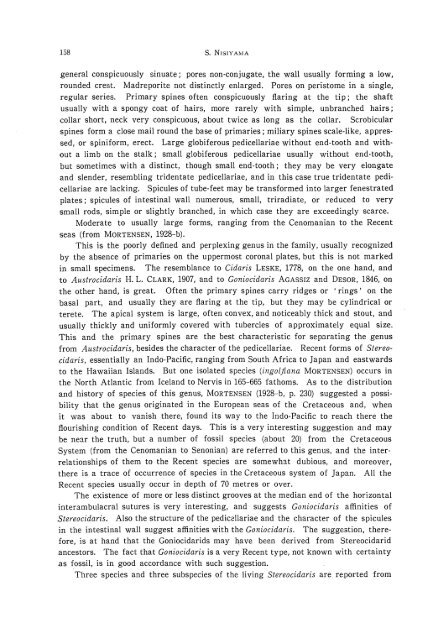the echinoid fauna from japan and adjacent regions part i
the echinoid fauna from japan and adjacent regions part i
the echinoid fauna from japan and adjacent regions part i
You also want an ePaper? Increase the reach of your titles
YUMPU automatically turns print PDFs into web optimized ePapers that Google loves.
158 S. NISIYAMA<br />
general conspicuously sinuate; pores non-conjugate, <strong>the</strong> wall usually forming a low,<br />
rounded crest. Madreporite not distinctly enlarged. Pores on peristome in a single,<br />
regular series. Primary spines often conspicuously flaring at <strong>the</strong> tip; <strong>the</strong> shaft<br />
usually with a spongy coat of hairs, more rarely with simple, unbranched hairs;<br />
collar short, neck very conspicuous, about twice as long as <strong>the</strong> collar. Scrobicular<br />
spines form a close mail round <strong>the</strong> base of primaries; miliary spines scale-like, appressed,<br />
or spiniform, erect. Large globiferous pedicellariae without end-tooth <strong>and</strong> without<br />
a limb on <strong>the</strong> stalk; small globiferous pedicellariae usually without end-tooth,<br />
but sometimes with a distinct, though small end-tooth; <strong>the</strong>y may be very elongate<br />
<strong>and</strong> slender, resembling tridentate pedicellariae, <strong>and</strong> in this case true tridentate pedicellariae<br />
are lacking. Spicules of tube-feet may be transformed into larger fenestrated<br />
plates; spicules of intestinal wall numerous, small, triradiate, or reduced to very<br />
small rods, simple or slightly branched, in which case <strong>the</strong>y are exceedingly scarce.<br />
Moderate to usually large forms, ranging <strong>from</strong> <strong>the</strong> Cenomanian to <strong>the</strong> Recent<br />
seas (<strong>from</strong> MORTENSEN, 1928-b).<br />
This is <strong>the</strong> poorly defined <strong>and</strong> perplexing genus in <strong>the</strong> family, usually recognized<br />
by <strong>the</strong> absence of primaries on <strong>the</strong> uppermost coronal plates, but this is not marked<br />
in small specimens. The resemblance to Cidaris LESKE, 1778, on <strong>the</strong> one h<strong>and</strong>, <strong>and</strong><br />
to Austrocidaris H. L. CLARK, 1907, <strong>and</strong> to Goniocidaris AGASSIZ <strong>and</strong> DESOR, 1846, on<br />
<strong>the</strong> o<strong>the</strong>r h<strong>and</strong>, is great. Often <strong>the</strong> primary spines carry ridges or 'rings' on <strong>the</strong><br />
basal <strong>part</strong>, <strong>and</strong> usually <strong>the</strong>y are flaring at <strong>the</strong> tip, but <strong>the</strong>y may be cylindrical or<br />
terete. The apical system is large, often convex, <strong>and</strong> noticeably thick <strong>and</strong> stout, <strong>and</strong><br />
usually thickly <strong>and</strong> uniformly covered with tubercles of approximately equal size.<br />
This <strong>and</strong> <strong>the</strong> primary spines are <strong>the</strong> best characteristic for separating <strong>the</strong> genus<br />
<strong>from</strong> Austrocidaris, besides <strong>the</strong> character of <strong>the</strong> pedicellariae. Recent forms of Stereocidaris,<br />
essentially an Indo-Pacific, ranging <strong>from</strong> South Africa to Japan <strong>and</strong> eastwards<br />
to <strong>the</strong> Hawaiian Isl<strong>and</strong>s. But one isolated species (ingolfiana MORTENSEN) occurs in<br />
<strong>the</strong> North Atlantic <strong>from</strong> Icel<strong>and</strong> to Nervis in 165-665 fathoms. As to <strong>the</strong> distribution<br />
<strong>and</strong> history of species of this genus, MORTENSEN (1928-b, p. 230) suggested a possibility<br />
that <strong>the</strong> genus originated in <strong>the</strong> European seas of <strong>the</strong> Cretaceous <strong>and</strong>, when<br />
it was about to vanish <strong>the</strong>re, found its way to <strong>the</strong> Indo-Pacific to reach <strong>the</strong>re <strong>the</strong><br />
flourishing condition of Recent days. This is a very interesting suggestion <strong>and</strong> may<br />
be near <strong>the</strong> truth, but a number of fossil species (about 20) <strong>from</strong> <strong>the</strong> Cretaceous<br />
System (<strong>from</strong> <strong>the</strong> Cenomanian to Senonian) are referred to this genus, <strong>and</strong> <strong>the</strong> interrelationships<br />
of <strong>the</strong>m to <strong>the</strong> Recent species are somewhat dubious, <strong>and</strong> moreover,<br />
<strong>the</strong>re is a trace of occurrence of species in <strong>the</strong> Cretaceous system of Japan. All <strong>the</strong><br />
Recent species usually occur in depth of 70 metres or over.<br />
The existence of more or less distinct grooves at <strong>the</strong> median end of <strong>the</strong> horizontal<br />
interambulacral sutures is very interesting, <strong>and</strong> suggests Goniocidaris affinities of<br />
Stereocidaris. Also <strong>the</strong> structure of <strong>the</strong> pedicellariae <strong>and</strong> <strong>the</strong> character of <strong>the</strong> spicules<br />
in <strong>the</strong> intestinal wall suggest affinities with <strong>the</strong> Goniocidaris. The suggestion, <strong>the</strong>refore,<br />
is at h<strong>and</strong> that <strong>the</strong> Goniocidarids may have been derived <strong>from</strong> Stereocidarid<br />
ancestors. The fact that Goniocidaris is a very Recent type, not known with certainty<br />
as fossil, is in good accordance with such suggestion.<br />
Three species <strong>and</strong> three subspecies of <strong>the</strong> living Stereocidaris are reported <strong>from</strong>












